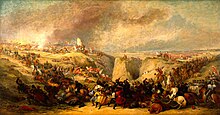| Battle of Hyderabad | |||||||
|---|---|---|---|---|---|---|---|
| Part of British conquest of Sindh | |||||||
 The Battle of Hyderabad by George Jones | |||||||
| |||||||
| Belligerents | |||||||
|
|
| ||||||
| Commanders and leaders | |||||||
|
|
Mir Sher Muhammad Talpur Hoshu Sheedi † | ||||||
| Units involved | |||||||
|
1st Troop Bombay Horse Artillery, 9th Bombay Light Horse, 1st Grenadier Regiment of Bombay Native Infantry, 12th Bombay Native Infantry, 21st Bombay Native Infantry, 25th Bombay Native Infantry, 22nd Cheshire Regiment of foot, Poona Irregular Horse 36th Jacob's Horse | Unknown | ||||||
| Strength | |||||||
| 6,000 | 15,000 | ||||||
| Casualties and losses | |||||||
| 39 dead, 231 wounded | 2,000[2] | ||||||
The Battle of Hyderabad (Sindhi: ڊبو جي جنگ), sometimes called the Battle of Dubbo,[3] was one of the major campaigns of the British against Sindh, which was fought on 24 March 1843 between the forces of the British East India Company and the Talpur Mirs of Sindh near Hyderabad, Sindh, Pakistan. A small British force, led by Captain James Outram, was attacked by the Talpurs and forced to make a fort of the British residence, which they successfully defended until they finally escaped to a waiting river steamer. After the British victory at Meeanee (also spelt Miani), Sir Charles James Napier continued his advance to the Indus River and attacked the Sindh capital of Hyderabad.
Hyderabad was defended by 20,000 troops and Baloch tribes under the command of His Highness Mir Sher Muhammad Khan Talpur "Sher-i-Sindh" and Hosh Mohammad Sheedi. Charles Napier with a force of only 3,000 men but with artillery support stormed the city. During the battle, Hosh Mohammad Sheedi was killed and his forces routed; Talpurs resistance collapsed and Sindh came under British control.


- ^ Outram, James (2009). The Conquest of Scinde: A Commentary. Bibliolife. p. 451. ISBN 978-0-559-94134-4.
- ^ Moon, The British Conquest and Dominion of India, p. 574.
- ^ Khuhro, Hamida (1998). Mohammed Ayub Khuhro: A Life Of Courage In Politics. Oxford University Press. p. 18. ISBN 969-0-01424-2.
